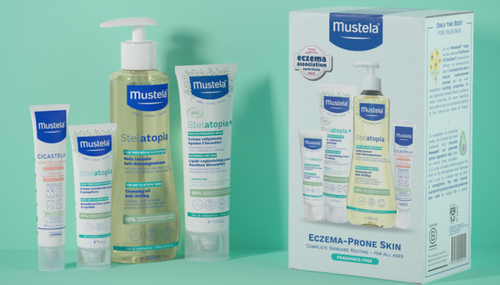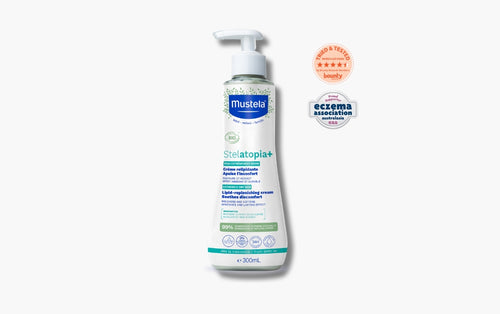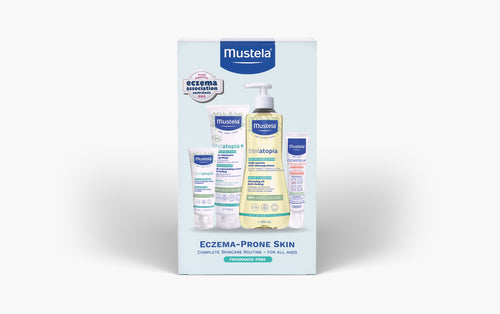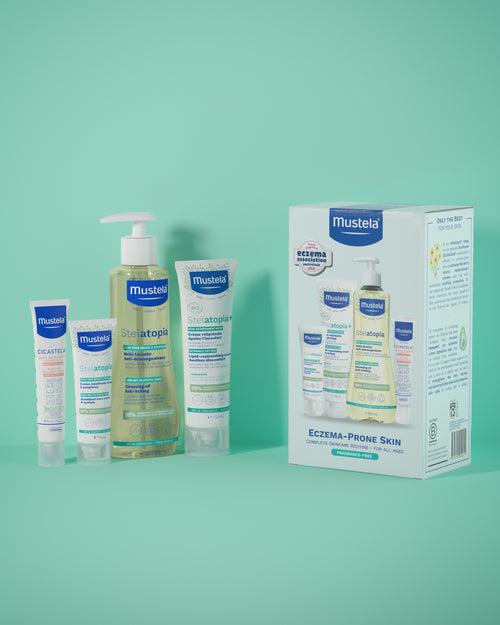Managing eczema during summer with sun exposure requires a careful, personalised approach that balances potential benefits with protective measures. Here's your comprehensive guide:
How Sun Exposure Affects Eczema: Benefits, Risks & Protection
Does sun help eczema?
The answer depends entirely on your individual skin response and atopic dermatitis severity. Evidence indicates that moderate UV exposure can benefit many Australians with eczema through increased vitamin D production and natural anti-inflammatory effects.
However, our harsh Australian climate requires extra caution. Studies reveal that while some people experience significant improvement during summer holidays, others develop photosensitive reactions or heat-triggered flares.
Patch test any new sun protection products before full application. The best option involves starting with brief morning exposure while monitoring your skin's reaction, particularly during different parts of the day when UV intensity varies across our diverse climate zones.
Benefits of controlled sun exposure
Research demonstrates that UV rays trigger specific immune responses that can dramatically improve eczema symptoms. Clinical findings show that sunlight activates regulatory T cells in the skin, which actively suppress inflammatory reactions responsible for itching and redness.
Beyond immune modulation, controlled exposure enhances the skin's natural barrier function through increased vitamin D synthesis. This process strengthens the protective layer that prevents allergens and irritants from penetrating deeper skin layers.
Antimicrobial properties of UV light also play a crucial role by reducing harmful bacteria on the skin surface. Data confirms that approximately 60% of patients experience noticeable symptom relief during supervised sun therapy, with many reporting decreased flare frequency and intensity.
The drying effect of moderate sunlight particularly benefits those with weeping or blistering eczema patches, helping to reduce moisture-related complications while promoting healing.
When sunlight can trigger eczema flares
Heat and sweating represent the primary culprits behind sun-induced flare-ups. Your skin's temperature rises during UV exposure, triggering perspiration that irritates already compromised barrier function and intensifies itching sensations.
Overexposure leads to sunburn, which damages the protective skin barrier and creates inflammatory responses identical to eczema reactions. This dual assault overwhelms your skin's natural healing capacity, often resulting in more severe symptoms than the original condition.
Photosensitive reactions occur when certain medications, skincare products, or even natural skin compounds become activated by UV rays. Ingredients like octocrylene in sunscreens can paradoxically trigger photoallergic contact dermatitis, creating flares specifically in sun-exposed areas like the face, neck, and forearms.
Timing matters significantly - flares may appear immediately after exposure or develop days later, making it challenging to identify the connection between sun exposure and worsening symptoms.
Finding the right balance for your skin
Start with short exposure periods of 10-15 minutes during early morning hours when UV intensity remains gentler on sensitive skin. Your individual tolerance level determines the optimal duration, which may vary significantly from others with eczema.
Monitor your skin's response over several days before extending exposure time. Watch for increased redness, itching, or dryness that signals you've exceeded your threshold.
Consider protective clothing as your primary defence, using sunscreen only on exposed areas like hands and face. This approach minimizes potential reactions from active ingredients while still allowing beneficial UV contact with covered skin areas.
Consult your healthcare professional about timing sun exposure around your treatment schedule, particularly if using topical medications that may increase photosensitivity.
Australian sun intensity considerations
Australia's UV Index frequently exceeds 10 during peak summer months, creating conditions far more intense than most global regions.
The Cancer Council data reveals that Australian UV levels can cause sunburn within 15 minutes, making traditional sun exposure recommendations inadequate for people with eczema. Northern territories experience particularly harsh conditions where even brief exposure through windows can aggravate sensitive skin conditions.
Altitude and proximity to the ozone hole amplify these effects significantly. Cities like Melbourne and Sydney face additional challenges from reflected UV rays off concrete and water surfaces, requiring adapted protection strategies that account for both direct and indirect exposure throughout the day.
Seasonal Eczema
Warmer months bring distinct challenges as heat and perspiration become primary triggers for many Australians managing atopic dermatitis. Your skin's response may shift dramatically between seasons, with some experiencing relief during winter's cooler temperatures while others struggle with indoor heating and reduced humidity.
Spring presents unique complications through increased pollen exposure, which can worsen symptoms before summer's beneficial effects take hold. Researchers have documented that seasonal transitions often trigger flare-ups as your skin adapts to changing environmental conditions.
Winter's dry air strips natural moisture from compromised barriers, making spring sun exposure potentially more beneficial after months of indoor heating damage. Understanding your personal seasonal patterns helps predict when extra protection or modified treatment approaches become necessary for maintaining stable skin health year-round.
Choosing the best sunscreen for eczema-prone skin
Mineral vs chemical sunscreen for dermatitis and sensitive skin
Mineral sunscreens containing zinc oxide or titanium dioxide create a physical barrier that reflects UV rays away from your skin surface. These formulations sit on top of the skin rather than absorbing into deeper layers, making them the safer choice for eczema-prone individuals.
Chemical filters like oxybenzone work by penetrating the skin and converting UV radiation into heat energy. This absorption process can trigger allergic reactions and eczema flare-ups, especially when combined with Australia's intense sun exposure.
Zinc oxide offers additional anti-inflammatory properties that actively soothe irritated skin while providing broad-spectrum protection. Unlike chemical alternatives, mineral formulations work immediately upon application without requiring a 20-minute waiting period before sun exposure.
Essential SPF and broad-spectrum protection
SPF 30 represents the minimum protection level dermatologists recommend for eczema-prone skin, blocking approximately 97% of harmful UVB radiation. Higher values like SPF 50 increase this protection to 98%, providing crucial defence against burning rays that can trigger inflammatory responses in compromised skin barriers.
Broad-spectrum coverage ensures defence against both UVA and UVB wavelengths simultaneously. UVA rays penetrate deeper into skin layers, causing long-term damage and potentially worsening existing eczema symptoms through cellular inflammation.
Look for products displaying the broad-spectrum label alongside appropriate SPF numbers. This combination guarantees comprehensive protection that addresses both immediate burning risks and deeper tissue damage that could compromise your skin's healing capacity during treatment phases.
Hypoallergenic sunscreen features to prioritise
Seek out products displaying the National Eczema Association Seal of Acceptance, which indicates rigorous testing for sensitive skin compatibility. These certified formulations undergo extensive evaluation to ensure minimal risk of triggering allergic reactions or eczema flares.
Water-resistant properties become particularly valuable during Australia's humid summer months when perspiration can compromise sunscreen effectiveness. Choose formulations that maintain protection for at least 40 minutes during swimming or sweating activities.
Non-comedogenic labelling prevents pore blockage that could worsen existing skin conditions. This feature proves especially beneficial for individuals managing both eczema and acne-prone areas simultaneously, ensuring comprehensive skin health without creating additional complications.
Alcohol-free formulations prevent the drying effects that can compromise your skin's protective barrier function. Products containing aloe vera or ceramides provide additional soothing benefits while delivering sun protection, creating a dual-action approach to sensitive skin care.
Water resistance for active lifestyles
Active families need sunscreen that stays put during swimming, sports, and outdoor adventures. Water-resistant formulations maintain their protective barrier for 40 to 80 minutes of continuous water exposure or heavy perspiration, crucial when managing eczema-prone skin that cannot afford gaps in coverage.
The 40-minute rating suits playground activities and light exercise, while 80-minute protection works better for beach days and competitive sports. During Australia's intense summer heat, even brief activities like walking to school can trigger significant sweating that compromises standard formulations.
Choose products specifically tested for sweat resistance alongside water protection. This dual capability supports children with eczema who participate in sports or spend extended periods outdoors, maintaining consistent UV defence without requiring frequent interruptions for reapplication during activities.
Fragrance-free formulations for allergy prevention
Fragrance represents one of the most common allergens found in conventional sunscreens, triggering contact dermatitis and eczema flares in sensitive individuals. Even products labelled "unscented" may contain masking fragrance to neutralise natural ingredient odours, making careful label reading essential for allergy prevention.
True fragrance-free formulations eliminate both added scents and essential oils that can provoke allergic reactions. These products undergo patch testing to verify their compatibility with compromised skin barriers, reducing the risk of developing new sensitivities over time.
Select products that explicitly state "fragrance-free" rather than "unscented" on their packaging. This distinction matters significantly for those managing eczema, as fragrance-free guarantees indicate thorough testing protocols designed specifically for sensitive skin conditions requiring gentle daily protection.
Application and daily sun care routine
Proper sunscreen application techniques
Begin application 30 minutes before sun exposure to allow your skin barrier to properly absorb the product without interference from residual emollients. This timing prevents dilution of the protective formula while ensuring optimal coverage across all exposed areas.
Use gentle, downward strokes when spreading the product rather than vigorous rubbing motions that could trigger itchiness. Apply approximately one teaspoon per limb and face, paying special attention to commonly missed spots like ears, neck sides, and temples where eczema flares frequently develop.
For spray formulations, dispense the product into your palms first before applying to facial areas. This technique provides better control and prevents accidental inhalation while ensuring even distribution across sensitive skin zones that require careful handling during application.
Combining emollients with sun protection
Allow 30 minutes between applying your emollient and sunscreen to prevent dilution of the protective formula. This waiting period ensures your moisturiser fully absorbs into compromised skin barriers without interfering with SPF effectiveness.
Pat your emollient gently into damp skin first, focusing on areas prone to dryness or active eczema patches. The moisturiser creates a protective base layer that helps prevent the frying effect that can occur when unprotected emollients meet direct sunlight.
During warm weather, lighter emollient textures prevent excessive buildup while maintaining barrier protection throughout extended outdoor activities.
For enhanced protection during sun exposure, consider incorporating Mustela's Stelatopia+ Lipid-Replenishing Cream into your daily routine. This certified organic emollient cream contains 99% natural ingredients including Prebiotic Bioecolia® and Sunflower Oil Distillate, providing 24-hour hydration while strengthening your skin's moisture barrier. Clinical studies show this formulation significantly improves skin barrier function, soothes itchy skin and helps minimize recurring itch frequency. Safe for the whole family including newborns, this fragrance-free cream absorbs quickly without sticky residue, making it an ideal base layer before sunscreen application to support your skin's natural defences against UV-related flare-ups.
Reapplication timing for sensitive skin
Every two hours represents the absolute minimum for reapplication, yet eczema-prone skin demands more frequent attention during Australia's harsh conditions. Swimming, towelling off, or excessive sweating triggers immediate reapplication needs regardless of time elapsed since your last application.
Watch for visual cues that indicate compromised protection. When your skin appears shiny from perspiration or feels sticky from humidity, these signals demand fresh sunscreen coverage before UV damage occurs.
During middle of the day exposure between 10am and 3pm, consider reapplying every 90 minutes instead of the standard two-hour interval. Sensitive skin burns faster than healthy barriers, making extra steps worthwhile for preventing painful flares that could set back your eczema management progress significantly.
Post-sun care for eczema-prone skin
Cool water provides immediate relief after sun exposure, helping calm heated skin without shocking sensitive areas. Lukewarm baths work better than cold showers, which can trigger additional irritation on compromised barriers.
For gentle cleansing after sun exposure, consider Mustela's Stelatopia Cleansing Oil, specifically formulated for eczema-prone skin. This fragrance-free, cleanser contains 98% natural ingredients including sunflower oil distillate, which helps restore your skin's protective barrier while removing sunscreen residue without harsh scrubbing. Its oil-based formula creates a protective film that prevents the drying effects of water, making it ideal for post-sun bathing routines when your skin needs extra gentle care.
Pat skin dry with soft towels rather than rubbing motions that could worsen inflammation. Apply your regular emollient while skin remains slightly damp to lock in moisture and support barrier repair throughout the evening hours.
Cooling gels containing aloe vera offer targeted relief for areas showing redness or discomfort. Store these products in the refrigerator for enhanced soothing effects when applied to sun-exposed zones requiring extra attention.
Monitor your skin closely over the following 24-48 hours for signs of delayed reactions. Increased itching, unusual dryness, or new patches signal the need for gentle care adjustments and possible consultation with your healthcare provider.
Managing sun exposure during flare-ups
Active eczema episodes require complete sun avoidance until inflammation subsides and skin barriers begin healing. Inflamed patches become extremely vulnerable to UV damage, potentially extending flare duration by weeks rather than days.
Consider indoor activities during peak UV hours when symptoms are severe. Air conditioning provides relief from heat triggers while maintaining comfortable temperature control that prevents excessive sweating and irritation.
Topical corticosteroids can increase photosensitivity in rare cases. Coordinate treatment timing with your dermatologist to determine safe exposure windows that won't interfere with medication effectiveness or trigger photoallergic reactions.
When venturing outdoors becomes necessary, protective clothing offers superior defence compared to sunscreen alone. Choose loose-fitting garments that create barrier protection without trapping heat against compromised skin areas requiring gentle healing conditions.
Managing Eczema During Summer Heat
Cooling Strategies and Clothing Choices
Loose-fitting cotton garments provide superior temperature regulation compared to synthetic materials that trap heat against inflamed skin. Natural fibres like bamboo and linen allow air circulation while wicking moisture away from sensitive areas.
Light-coloured fabrics reflect heat more effectively than darker options, preventing your body from absorbing excess warmth during outdoor activities. Consider packing spare clothing when spending extended periods outside, as changing from damp garments prevents salty residue from dried sweat irritating compromised skin barriers.
Portable cooling devices offer immediate relief when temperatures spike unexpectedly. Battery-operated fans, cooling towels stored in insulated bags, and chilled water bottles create instant comfort zones wherever you are. Seeking shaded areas during peak UV hours between 10am and 4pm reduces both heat exposure and potential photosensitive reactions that can complicate existing eczema symptoms.
Is salt water good for eczema?
Ocean water presents a complex relationship with eczema-prone skin that varies dramatically between individuals. Research shows that natural seawater contains beneficial minerals including magnesium, calcium, and potassium that can reduce inflammation and support barrier function repair.
Studies indicate these minerals help cleanse harmful bacteria while providing antimicrobial properties that may prevent secondary infections. Magnesium specifically enhances skin hydration by strengthening compromised barriers common in atopic dermatitis sufferers.
However, salt water can sting severely on broken or actively inflamed patches, particularly during initial exposure. The high sodium content may cause excessive drying in some people, potentially worsening symptoms rather than improving them.
Dermatologists note that individual tolerance varies significantly based on current skin condition and eczema severity. Testing your reaction in controlled environments like saltwater pools before ocean swimming helps determine personal compatibility safely.
Are Swimming Pools Safe for Eczema-Prone Skin?
Chlorinated pools create a unique environment that can benefit certain eczema sufferers through antimicrobial action against harmful bacteria commonly found on compromised skin. The diluted concentration mirrors therapeutic bleach baths recommended by dermatologists for managing bacterial overgrowth.
However, prolonged exposure strips natural oils from already vulnerable skin barriers. Frequent swimmers and lifeguards show higher eczema rates due to repeated chlorine contact damaging protective layers over time.
Pool chemistry matters significantly - properly balanced chlorine levels cause less irritation than poorly maintained facilities. Immediate post-swim rinsing becomes crucial for removing chemical residue that continues affecting skin long after leaving the water.
Personal tolerance varies widely, making individual testing the most reliable approach for determining compatibility with your specific condition.














